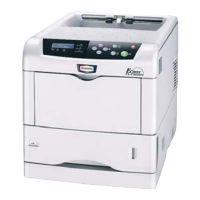Computer Interface
ADVANCED OPERATION GUIDE 4-3
Parallel Interface (FS-C5030N only)
Communication Modes
The printer provides high-speed data transmission on a parallel interface.
You can select the parallel interface communication mode from the
operation panel. To change communication mode, see Changing Parallel
Interface Mode (FS-C5030N only) on page 2-29.
NOTE: Use a parallel interface cable that complies with the IEEE 1284
standard.
You can choose from four communication modes:
Interface Signals
Table shows the connector pins and corresponding input and output
signals of the parallel interface. Explanation of each signal is also given in
the table.
The description in [ ] indicates signal names in Auto mode and Nibble
(high) mode (IEEE 1284-compliant). In Auto and Nibble modes, these
signals are bidirectional.
Communication
Mode
Reception Transmission
Auto (default) High-speed/ECP Nibble/ECP
Nibble High-speed Nibble
High-speed High-speed —
NormalNormal—
Pin
In or
out
Signal Description
1 In Strobe
†
[nStrobe] A negative-going-strobe pulse causes the printer to read and
latch the data on the Data 0 [1] to Data 7 [8] signal lines.
2 In Data 0 [Data 1] These eight signals form one byte of data sent from host
computer to printer. Data 7 [8] is the most significant bit.
3 In Data 1 [Data 2]
4 In Data 2 [Data 3]
5 In Data 3 [Data 4]
6 In Data 4 [Data 5]
7 In Data 5 [Data 6]
8 In Data 6 [Data 7]
9 In Data 7 [Data 8]

